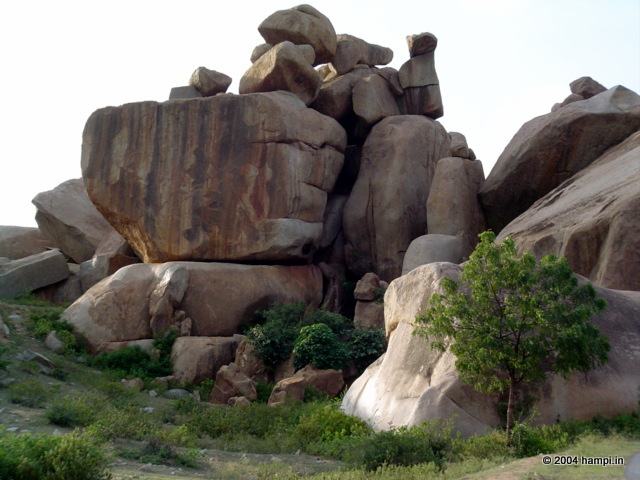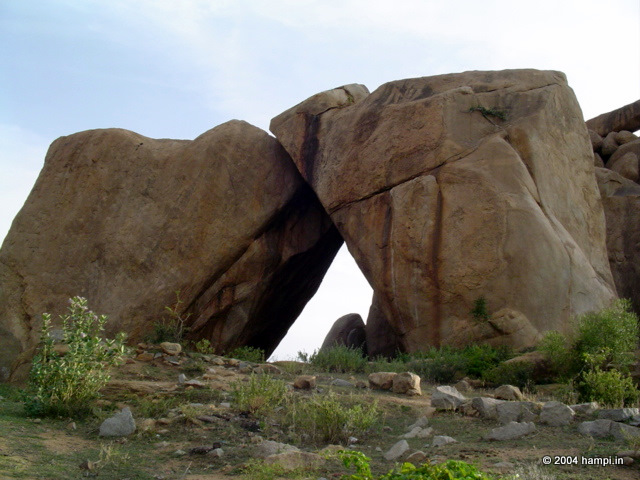Hampi Boulders

I
t is difficult to tell what is more charming in Hampi , weather its thrilling architecture or the bizarre looking landscape. While the architecture is a lot easy to comprehend, any average visitor to Hampi would wonder how come on earth such a landscape was created. If you look around , no clues are found either!Yes, we are talking about the boulder strewn landscape of Hampi. For those who have not been to Hampi, the landscape of it is made of miles and miles of boulder heaps. They form hills, valleys, riverbed... practically every topography of Hampi. The boulder strewn landscape is what as far as eyes can see. Then comes the most perplexing part. That is the way the boulders are "arranged", rather standing in delicate balance, expecting a topple any moment. Who has placed them in that way? The answer is Nature.
Millions of years back there was no boulder on the surface of Hampi the way we see it now. The wind and rain has continuously swept away the soft soil, exposing the hard rocky outcrops. In fact what you see in Hampi is one of the oldest surfaces one can see on earth.
Thanks to the elements, and the fault lines on these rocky surfaces, cracks formed and the never-ending boulder formation started. The natural erosion polished the cyclopean boulders into bizarre shapes. Unlike how pebbles are polished in the flowing water of a river, Hampi's boulders were formed by blowing wind. The strongly blowing sandy wind was something like rubbing a hard surface with sandpaper. This continued for many thousands of years, crafting the landscape of Hampi. The result is the mysterious looking landscape, as if god had emptied a bag of boulders over Hampi.
Talking of god, there is no dearth of mythology related Hampi. According to one Hampi is the setting of some parts of Ramayana, the Hindu epic poem. The place was a monkey kingdom. Two monkey brothers, Vali and Sugreeva , were at war over the throne of the kingdom. The boulders strewn all over Hampi is what they threw at each other during the battles.
Leaving the gods behind let's see what men did with Hampi's boulders.Believe it or not, they made an imperial capital city literally out of boulders. The founders of the Vijayanagara empire ( of which Hampi was the capital ) chose this for many reasons. Their guru advised them of the spiritual powers of the place to install a capital. From a strategic point this had many advantages. The chain of boulder hills made a natural fortress around a vast area. At one end is the long and torrential Tungabhadra river, as if it makes the impregnable border of a empire that it becomes a few centuries later.
To understand this just climb to the top of Matunga Hill, the tallest point inside the citadel. You can get a panorama of the chain of hills as if it marks the horizon.
They could built such beautiful and extravagant structures in Hampi, thanks to the availability of granite blocks in whatever size they wanted.
The result was unending rows of civil,military and religious structures that were built by many kings of Vijayanagara over many centuries. Even in dealing with the granites, they followed certain norms are ingenuities. For example, boulders were rarely quarried from certain areas of Hampi thanks to its religious sanctity. In other words many hills considered sacred were left intact, other than constructing temple and shrines over it.
Another interesting part of Vijayanagara Architecture is the way they sliced the boulders. All what they needed was some rudimentary metal tools to make some holes, a few wooden pegs and a little bit of water to split neatly a boulder as big as an elephant.
The first thing was to select a boulder and make the cutting plan. The use of this boulder decided both. For example, for the massive monolithic pillars, the artisans required granite blocks of the comparable size as the basic material to do the carvings. For the type of Hampi's architecture they needed many identical blocks of granite in large quantities.
Once the size of the basic block is decided the quarrying process is initiated, possibly from the nearest possible location. A series of holes,about 3 or 4 inches deep, are dug along the line of the required cut. The holes are typically 4 to 6 inches apart in a straight line.
One this is done, the next process is to drive wooden pegs into these holes.This as such doesn't split the boulder. But when these pegs are then made to expand by soaking it with water the story is different. The enormous force these pegs would apply along the line makes the boulder split neatly into two pieces. The process is repeated till the required size of the granite block is achieved. In all probability the would have pressed many elephants into service to move the quarried granite blocks to the final place of work.
Other than using the boulders as a building material, the boulder were used in situ at many places, especially as religious artefacts. For example the two giant images of Ganapathi in Kadlekalu Ganesha Temple and the Sasivekalu Ganesha Temple where originally giant boulders. Later these idols where carved out of the boulders in situ and the temple is built around it. Same is the case with the Kodandarama Temple on the river side and the giant monolithic Nandi at the end of the Hampi Bazaar.
Apart from these massive works, you can also see hundreds of religious images carved on the boulder surfaces as you move around in the Hampi ruins.
The empire crumbed after a few hundred years of its existence. But the boulders of Hampi survived. So is the signature left by the Vijayanagara art on the surface of these boulders.
Of late the boulders of Hampi has another set of fanfare following. That is the bouldering enthusiasts from all around the world. Bouldering is an outdoor sports, that is essentially climbing a large boulder simply with the use of bare hands.
So boulders are selected for its difficulty to climb. It their language each selected boulder is a "problem" they climb and "solve". The level of difficulty of the problem is often graded. Some of the popular problems ( read as boulders) are even named. Experiences bourderers tries to solve each problems using various techniques they have mastered. These tips ( called beta) are then passed on to fellow boulderers.
So what makes Hampi special among the bouldering fraternity? The endless variety of "problems" Hampi offers in terms of its millions of boulders. Weather one is a novice boulderer or one with international reputation, Hampi has many problems for them to solve.
Come the cooler and rainless months of the year, hundreds of bouldering fans descend to Hampi from all around the world. And the boulders of Hampi absorbs them all with remarkable ease.
Needless to say , bouldering is one of the least damaging kind of outdoor sports from an environmental perspective. If leaving footprint is considered alright, they rather prefer to leave behind a few chalk powder smeared finger marks on the boulder, for the next monsoon rain to wash it off!
That's all about the boulders of Hampi!

A balancing boulder atop Malayavanta Hill
A balancing boulder atop Malayavanta Hill

The precariously balancing boulders of Hampi
The precariously balancing boulders of Hampi. Makes bouldering in Hampi a thrilling sport.

Akka Tangi Gudda ('Sister Boulders') in Hampi
This picture was taken before the boulder was collapsed in 2011. Note the fissure on the right boulder. Over the years the boulder cracked along this fissure and partly collapsed.
